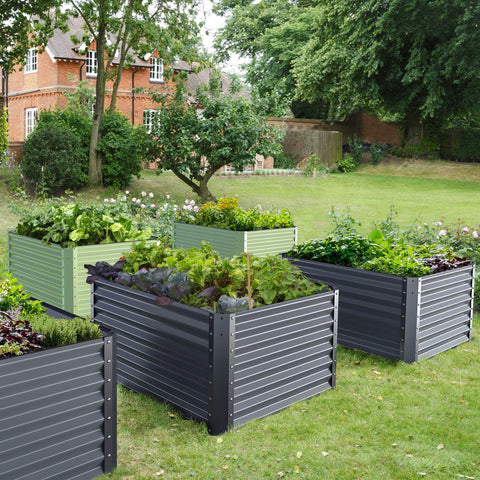Introduction: Elevating Culinary Delights in Your Backyard
For culinary enthusiasts and adventurous cooks, the allure of gourmet gardening lies in the opportunity to cultivate a repertoire of rare and exquisite ingredients right in their backyard. In this blog, we explore the cultivation of ten rare and exquisite ingredients, unraveling the appeal, growing tips, and culinary use of each to elevate your culinary creations to new heights.

1. Saffron Crocus: The Gold of Gourmet Gardens
Appeal:
- Saffron, often referred to as the "red gold," is derived from the crimson stigmas of the saffron crocus. Known for its distinct flavor and rich color, saffron is a coveted spice that adds a touch of luxury to dishes.
Growing Tips:
- Saffron crocus bulbs thrive in well-drained soil and sunny locations. Plant them in late summer or early autumn, and patiently await the fall harvest when you can collect the precious saffron threads.
Culinary Use:
- Saffron imparts a distinct color and flavor to dishes, making it a prized addition to risottos, paellas, and desserts. The homegrown saffron brings an unparalleled freshness to your gourmet

2. White Truffle: Earthy Elegance in Your Garden
Appeal:
- White truffles, known for their intense aroma and earthy flavor, can be cultivated in your own truffle orchard. While the process requires patience, the reward is the culinary luxury of fresh truffles.
Growing Tips:
- Truffles form a symbiotic relationship with certain tree roots. Oak and hazelnut trees are commonly used as host plants. The soil should be well-drained, and the location should mimic the truffle's natural habitat.
Culinary Use:
- Shave fresh white truffle over pasta, risotto, or scrambled eggs to savor its exquisite flavor. The homegrown truffle elevates your dishes with a nuanced complexity that is hard to achieve with commercially available truffles.

3. Wasabi: Spice Up Your Garden and Cuisine
Appeal:
- Wasabi, the fiery green condiment often paired with sushi, can be cultivated in your garden. The plant requires specific conditions, but with dedication, you can enjoy the pungent kick of fresh wasabi at home.
Growing Tips:
- Wasabi thrives in cool, shaded conditions with ample moisture. Plant it in well-drained, sandy soil, and mimic the natural habitat of stream banks for optimal growth.
Culinary Use:
- Grate fresh wasabi rhizomes to accompany sushi, sashimi, or other dishes. The homegrown wasabi offers a vibrant spiciness that surpasses the often diluted commercial versions.
4. Vanilla Orchid: A Sweet Symphony in Your Garden
Appeal:
- Vanilla, a staple in sweet treats, comes from the orchid Vanilla planifolia. Cultivating your own vanilla orchid not only provides the key ingredient for desserts but also adds a touch of tropical elegance to your garden.
Growing Tips:
- Vanilla orchids thrive in warm, humid conditions. They require support for their climbing vines and are often grown on trellises or arbors. Mimic the tropical environment with filtered sunlight and consistent moisture.
Culinary Use:
- Harvest vanilla beans and infuse them into creams, custards, or desserts for a rich and aromatic flavor. The homegrown vanilla imparts a depth of flavor that enhances your sweet creations.

5. Meyers Lemon: Citrus Elegance at Your Fingertips
Appeal:
- Meyers lemon, a cross between a lemon and a mandarin orange, brings a sweeter and more fragrant citrus flavor to your garden. This elegant citrus variety is a delightful addition to gourmet gardening.
Growing Tips:
- Meyers lemon trees thrive in well-drained, slightly acidic soil. They are suitable for container gardening, making them accessible to gardeners with limited space. Provide ample sunlight for optimal fruiting.
Culinary Use:
- Use Meyers lemons in both sweet and savory dishes. Their fragrant zest and juice elevate cocktails, desserts, and seafood dishes to gourmet The homegrown Meyers lemon adds a nuanced citrus complexity to your culinary repertoire.
6. Edible Flowers: A Symphony of Colors and Flavors
Appeal:
- Incorporating edible flowers into your garden not only adds visual appeal but also introduces a spectrum of flavors to your dishes. Varieties like nasturtiums, violets, and pansies offer both beauty and taste.
Growing Tips:
- Choose edible flowers that are safe for consumption, and free from pesticides. Plant them in well-drained soil and provide adequate sunlight. Edible flowers often attract pollinators, contributing to the health of your garden.
Culinary Use:
- Decorate salads, desserts, or beverages with edible flowers. Their delicate flavors, ranging from peppery to sweet, add a gourmet touch to your culinary presentations. The homegrown edible flowers showcase your commitment to both aesthetics and taste.

7. Dragon Fruit: Tropical Elegance in Your Garden
Appeal:
- Dragon fruit, with its vibrant pink skin and speckled flesh, is not only visually striking but also boasts a mildly sweet flavor. Growing your own dragon fruit adds a tropical touch to your garden and culinary endeavors.
Growing Tips:
- Dragon fruit cacti thrive in well-drained soil and prefer a sunny location. Provide support for their climbing stems and ensure proper irrigation. The plant is well-suited for both ground and container cultivation.
Culinary Use:
- Enjoy dragon fruit on its own, in fruit salads, or as a refreshing smoothie ingredient. The homegrown dragon fruit adds a delightful burst of color and freshness to your tropical-inspired dishes.
8. Black Garlic: A Savory Transformation
Appeal:
- Black garlic is the result of a slow fermentation process that transforms regular garlic into a sweet and savory delicacy. Cultivating black garlic at home allows you to savor its unique flavor and enjoy its potential health benefits.
Growing Tips:
- Start with fresh garlic bulbs and ferment them in a controlled environment of low heat and high humidity. The process takes several weeks, during which the garlic undergoes enzymatic changes, resulting in its distinctive black color and complex flavor.
Culinary Use:
- Use black garlic in various dishes, such as pasta, sauces, or even as a topping for pizzas. Its sweet and umami-rich profile adds depth to your culinary creations. The homegrown black garlic offers a fresher alternative to store-bought varieties.

9. Purple Potatoes: Vibrant and Nutrient-Rich
Appeal:
- Purple potatoes, with their striking violet hue, not only add a burst of color to your garden but also boast a higher antioxidant content than their conventional counterparts. Growing purple potatoes at home provides a colorful and nutritious addition to your culinary repertoire.
Growing Tips:
- Plant purple potato tubers in well-drained, fertile soil with plenty of sunlight. As the plants grow, hilling or mounding soil around the base promotes tuber development. Harvest when the foliage begins to yellow and die back.
Culinary Use:
- Purple potatoes can be used in various dishes, from mashed potatoes to colorful salads. Their vibrant color and earthy flavor enhance the visual appeal and taste of your culinary creations. The homegrown purple potatoes offer a fresh and nutritious alternative to store-bought varieties.
10. Microgreens: Miniature Marvels of Flavor
Appeal:
- Microgreens, the tiny seedlings of vegetables and herbs, pack a powerful punch of flavor and nutrients. Growing your own microgreens allows you to experiment with diverse varieties, adding complexity to your dishes.
Growing Tips:
- Plant microgreen seeds in shallow containers with a soilless growing medium. Keep them in a well-lit location, and harvest when the first true leaves appear. Microgreens are quick to grow, making them an ideal choice for year-round cultivation.
Culinary Use:
- Sprinkle microgreens on salads, sandwiches, or as a garnish for various dishes. Their intense flavors and nutrient density enhance both the visual appeal and nutritional value of your culinary creations. The homegrown microgreens provide a continuous source of fresh and flavorful additions to your meals.
Conclusion: Gourmet Gardening, A Culinary Symphony
Embarking on the journey of gourmet gardening with these ten rare and exquisite ingredients not only expands your culinary palette but also transforms your garden into a haven of culinary marvels. Each plant, from saffron crocus to microgreens, brings its unique appeal, growing tips, and culinary use, offering a symphony of flavors and fragrances to your kitchen. As you nurture these gourmet delights in your backyard, may your garden become a sanctuary where the elegance of nature intertwines with the sophistication of culinary art, creating a gourmet symphony for the senses. Gourmet gardening is not just about growing ingredients; it's about savoring the essence of each plant and weaving it into the fabric of your culinary adventures.









